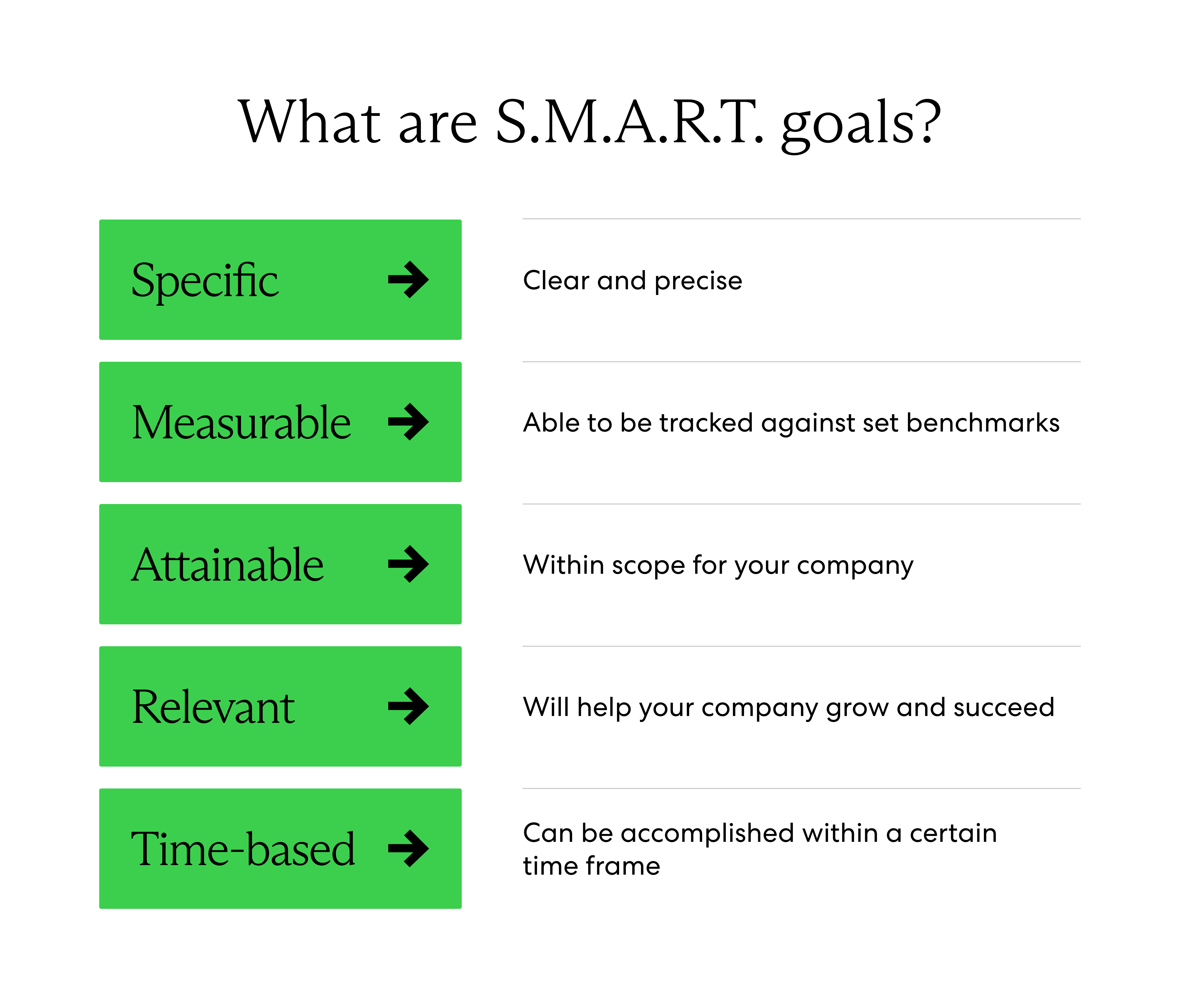The best team leaders share one thing in common: implementing leadership goals.
Setting goals is critical for leaders to improve their skill sets. Such leadership goals must be specific, measurable, attainable, relevant, and time-based (SMART) to help leaders create an actionable plan to grow and succeed.
With so much to do, business leaders may be tempted to push aside personal learning and development. However, investing the time to set and achieve SMART goals for your own leadership and management style can pay off in personal and business growth.
To help you become the best leader, we’ve compiled 15 examples of SMART goals and objectives that every leader should establish.
What are SMART goals?
The acronym SMART—Specific, Measurable, Achievable, Relevant, and Time-bound—is a structured framework for defining goal objectives with precision. When leaders implement SMART goals, they leverage a more thoughtful, measurable system that transforms abstract ambitions into actionable plans.
- Specific goals clarify exact objectives by defining what needs to be accomplished, why it matters, and how it will be achieved.
- Measurable criteria establish quantifiable indicators like metrics, deadlines, or percentages to track progress objectively.
- Achievable objectives ensure goals remain realistic given available resources, skills, and time constraints.
- Relevant goals align with broader organizational priorities or personal development needs.
- Time-bound deadlines create urgency and accountability by specifying start/end dates.
SMART goals in the workforce cultivate a culture of transparency, accountability, and adaptability within teams. By breaking down complex visions into manageable steps, leaders model strategic thinking and empower employees to replicate this approach in their own roles.
Note that the SMART framework is not static. It encourages continuous reflection where leaders regularly assess whether goals remain aligned with evolving organizational needs or external challenges, such as market shifts or technological advancements. Serving as both compass and roadmap, SMART goals help leaders navigate uncertainty while fostering environments of incremental progress.
15 SMART leadership goals

The following examples of leadership-driven SMART goals include developing your professional and emotional well-being.
1. Become more adaptable to change
The changing talent landscape amid the rise of remote work means that adaptability in the workplace is essential to leader effectiveness.
Many of today’s talent seek global mobility. They look for opportunities offering work-from-anywhere policies, life-work balance, and flexible schedules. In turn, business leaders must adjust their workforce model to serve those changing needs and reap the long-term benefits of lower employee turnover, improved morale, and better business success.
SMART goal: Survey your team for desired changes in the workplace—make those changes where feasible. Maybe that means allowing employees to work remotely or in a hybrid situation, or including free access to mental health resources in the employee rewards packages.
2. Learn to listen
Outstanding leaders are often the best active listeners—not merely hearing what someone says. Despite leaders spending approximately 63% of their day engaged in listening activities, they may only comprehend 25% of the topic. To bridge this gap, great leaders practice active listening, which means taking intentional steps—like not having an internal conversation with yourself—to digest and process what they hear. Harvard Business School’s Robin Abrahams and Boris Groysberg define active listening as “when you not only hear what someone is saying, but also attune to their thoughts and feelings. It turns a conversation into an active, non-competitive, two-way interaction.” You pay attention to body language and know when to ask appropriate questions. Not only do you glean valuable information, but you leave the employee feeling heard and improve their perception of you.
SMART goal: Schedule at least one weekly meeting with a direct report to practice active listening.
3. Focus on building relationships
The best leaders often develop strong relationships with their direct reports. Building these connections establishes trust across the team. These bonds help leaders identify individual strengths and ultimately contribute to better employee retention.
Strong relationships between leaders and team members create an inclusive and productive workplace culture. Effective leaders prioritize meaningful interactions with staff members. This approach transforms typical manager-employee dynamics into collaborative partnerships.
A report from Gallup revealed that those in leadership positions are responsible for 70% of the variance that drives employee engagement. In practice, a unified leader can inspire engagement, resulting in improved productivity and positive outcomes. Organizations that prioritize relationship-building see tangible benefits in performance while meeting the global workforce’s growing demand for workplace belonging.
SMART goal: Schedule one team dedicated to relationship building that gathers monthly for a group lunch, social activity, or team-building exercise.
4. Cultivate open-minded leadership
Effective leaders recognize diverse perspectives as catalysts for organizational innovation and growth. Remaining receptive to unconventional ideas allows teams to address complex challenges through collaborative problem-solving. This approach aligns with global workforce trends where distributed teams require leaders who balance decisiveness with intellectual flexibility.
“Being open-minded means more than just accepting new ideas; it’s about actively seeking them out,” advises Benjamin Backsmeier, Global Operations Executive. “Recently, I challenged our team with this theme: ’Be Open Minded.’ Why? Because even in established industries, disruption is always on the horizon,” Backsmeir adds.
SMART goal: Conduct quarterly anonymous pulse surveys assessing whether employees feel heard, targeting a 75% positive response rate. Analyze feedback to identify systemic patterns and implement three actionable changes annually based on survey insights.
5. Learn to take constructive criticism
Strong leaders embrace constructive criticism as an opportunity for growth and improvement. According to a LinkedIn study, 92% of professionals agree that constructive feedback effectively enhances performance. When leaders actively seek and act on upward feedback from their teams, they foster a culture of transparency and continuous improvement, which can boost both morale and productivity.
Encouraging upward feedback also signals to employees that their opinions are valued, strengthening trust and engagement. This approach is particularly vital in global organizations, where diverse perspectives can uncover unique insights and drive innovation.
SMART goal: Increase the percentage of employees providing upward feedback by 20%, demonstrating a workplace culture where team members feel safe and empowered to share constructive input.
6. Cultivate leadership confidence through strategic action
Teams consistently demonstrate higher engagement and performance when led by confident decision-makers. A Harvard study revealed that organizations with self-assured leaders achieve 50% greater productivity and 74% lower stress levels among employees. This correlation underscores confidence as a multiplier of trust and operational efficiency in global workforce management.
Effective confidence-building requires structured self-reflection and skill development. Leaders should conduct weekly reviews of strategic decisions and outcomes, identifying patterns in their strengths. Reports show leaders who focus on core competencies rather than weaknesses experience higher goal attainment rates. Pairing this practice with quarterly feedback sessions ensures alignment between self-perception and team perceptions.
SMART goal: Maintain a weekly journal documenting five leadership strengths or achievements, complemented by biannual 360-degree feedback assessments to identify growth areas and validate emerging capabilities.
7. Develop emotional intelligence for strategic leadership
Emotional intelligence (EQ) refers to the ability to identify, manage, and constructively express emotions—a critical skill for navigating complex workplace dynamics. Leaders with high EQ maintain team cohesion during challenging situations by balancing empathy with decisive action. This skill proves particularly vital in global organizations, where cultural nuances and remote collaboration demand heightened interpersonal awareness.
Effective leaders leverage EQ to de-escalate conflicts and foster psychological safety, creating environments where diverse talent thrives. For example, pausing to assess emotional undercurrents before responding to critical feedback often yields more productive outcomes than reactive approaches.
SMART goal: Maintain a daily journal for three months to reflect on emotional responses to workplace interactions, identifying patterns and developing three targeted strategies to improve conflict resolution tactics.
8. Master strategic delegation through self-awareness
Effective leaders prioritize self-awareness to balance responsibilities and avoid burnout. Strategic delegation empowers teams while allowing leaders to focus on high-impact initiatives. This practice builds trust and enhances operational efficiency, particularly in global organizations managing distributed workforces.
Delegating tasks aligned with employee strengths fosters skill development and accountability. “Incorporating self-awareness allows leaders to understand their strengths and limitations, assign tasks more effectively, and empower their team members,” says Jayakumar Sundararaj, a reputable IT leader. “This approach not only enhances productivity but also upholds the gold standard of leadership by fostering trust and collaboration,” he adds.
SMART goal: Delegate two responsibility-matched tasks weekly to direct reports, followed by biweekly feedback sessions to evaluate outcomes and refine delegation strategies quarterly.
9. Identify and leverage team members’ strengths
Understanding employees’ strengths and aligning tasks to their abilities significantly enhances workplace efficiency and morale. Gallup research shows that employees who know their strengths are 7.8% more productive, while teams that utilize strengths daily experience a 12.5% boost in productivity. This approach not only improves performance but also fosters a sense of fulfillment among team members, reducing turnover rates.
Recognizing strengths goes beyond technical skills—it includes problem-solving styles, interpersonal dynamics, and adaptability under pressure. Leaders who actively assess and apply these attributes create a culture where employees feel valued and empowered. This strategy is particularly impactful in global organizations, where diverse talents can drive innovation and collaboration across borders.
SMART goal: Conduct quarterly surveys asking employees to identify their strengths and challenges, then assign at least two tasks per quarter tailored to individual strengths to optimize team effectiveness.
10. Be a coach
More than just being a boss, leaders should work to uplift their team members. Managers and executives can do this by becoming mentors or coaches instead of being seen as just business leaders. To do this, work to provide training sessions and schedule meeting times to upskill employees and help them advance and grow.
Sharing experiences and expertise with teams can help employees become better at their jobs while also feeling like valuable assets to the company. And it won’t fall on unwilling ears, as 79% of people reported actively seeking out opportunities to learn new things at work.
SMART goal example: Managers can schedule a biweekly training session for team members where expertise and advice can be shared and discussed.
11. Implement structured positive feedback systems
Regular recognition significantly impacts employee retention and operational efficiency. Longitudinal studies reveal that teams receiving regular positive feedback demonstrate 45% lower turnover risk than their peers. Additionally, organizations prioritizing recognition report 9% productivity increases, translating to multimillion-dollar efficiency gains in large enterprises.
Effective systems leverage technology to celebrate achievements across global teams while accommodating cultural preferences. For example, public shout-outs may motivate some employees, while others prefer private acknowledgments. Tailoring delivery methods ensures that recognition resonates authentically across diverse workforces.
SMART goal: Launch a biweekly digital recognition program highlighting five employee contributions, measuring a 25% increase in peer-to-peer praise within three months through platform analytics.
12. Develop a growth mindset
A growth mindset empowers leaders to view challenges and setbacks as opportunities for learning and improvement. This perspective not only strengthens resilience but also fosters innovation and adaptability—qualities essential for navigating today’s dynamic global business environment. Leaders who embrace a growth mindset inspire their teams to take calculated risks, learn from failures, and continuously improve.
“Executives who lead their companies with a fixed mindset will create a culture of fear,” warns Daniel Marcos, CEO and co-founder of Growth Institute. “On the other hand, leaders who adopt a growth mindset will multiply their team’s potential and create a healthy culture of accountability that drives business growth,” Marcos adds.
Research by the NeuroLeadership Institute found that organizations fostering a growth mindset report higher employee engagement and adaptability, with employees feeling more prepared to thrive through change. By modeling this mindset, leaders create a culture where individuals are encouraged to develop new skills and tackle challenges with confidence, driving both personal and organizational success.
SMART goal: Attend two professional networking events per quarter, focusing on establishing at least one meaningful connection at each to expand knowledge and explore new growth opportunities.
13. Implement strategic time management practices
Effective time management serves as the cornerstone of operational efficiency in global organizations. An Atlassian study revealed that employees waste 31 hours monthly on unproductive meetings, highlighting the critical need for disciplined scheduling. Leaders who model punctuality and deadline adherence create a ripple effect, accelerating project timelines while respecting team capacity across time zones.
Prioritizing agenda-driven meetings and clear task delegation ensures alignment with strategic objectives. This approach proves particularly vital for managers overseeing multiple international projects, where coordinated timelines prevent workflow disruptions. Teams led by time-conscious executives often achieve faster decision-making cycles compared to industry benchmarks.
SMART goal: Implement a policy where 90% of meetings conclude at least five minutes early, utilizing saved time for focused work blocks. Track compliance through calendar analytics and adjust protocols quarterly based on team feedback.
14. Micromanage less
Business leaders may feel like their business is the most important thing in their lives and want to protect it. For some, this means overseeing every aspect of business operations and the work people are completing. But this ignores the valuable perspectives and processes that team members can bring to the table.
Constant micromanagement can lead to tension between boss and employee—especially since 69% of employees say they considered changing jobs because of it—so it’s important for business leaders to make delegation a priority. It’s a win-win: Teams will appreciate the trust, and leaders can get back to more important tasks on their plate.
SMART goal example: Reduce check-ins with employees about ongoing work and commit to only following up once per week or once the project is late or completed.
15. Build a dynamic, globally competitive team
Organizations prioritizing cognitive diversity and cross-functional collaboration achieve 39% higher innovation rates compared to homogeneous teams, according to McKinsey & Company. Dynamic teams blend varied cultural perspectives, skill sets, and problem-solving approaches—critical assets for companies operating across international markets. This diversity enables organizations to navigate regulatory complexities, cultural nuances, and emerging market trends with agility.
Leaders can foster dynamism by implementing bias-mitigation strategies in talent acquisition and rotation programs. For example, pairing team members from different geographic regions on projects often uncovers unconventional solutions to operational challenges.
SMART goal: Launch a six-month pilot program using structured interviews and AI-driven recruitment tools to reduce hiring biases by 40% while tracking retention rates and promotion velocity among new hires to measure cultural fit and performance impact.
How to write leadership goals
Though it can be difficult to look in the mirror and identify pain points, doing so can be essential for business success. To start writing SMART leadership goals and objectives, begin with the following steps:
- Identify strengths and weaknesses. Hone in on areas that actually need improvement, so start by thinking about areas that can be improved and areas that are strengths.
- Select the most important pain points. Identify the most relevant or pressing pain points in the office and make a list of them to get a better handle on the exact things to be targeted with goal-setting.
- Think of tangible ways to meet goals. “I want to improve employee communication” is vague, but “I want to hold bi-weekly employee events to facilitate bonding” is an actionable statement. Brainstorm ways to actually meet and measure goals and improvement.
- Create benchmarks for achieving goals. Long-term goals can feel overwhelming. Break goals into smaller chunks to better track progress and measure success.
- Ask for feedback. The purpose of SMART goal-setting is to improve team dynamics and performance. Ask for feedback from colleagues and direct reports while working on self-improvement.
Think SMART and set leadership goals
Goals are set by leaders to improve themselves so they can improve their teams in turn. From learning how to be an active listener to adapting to the ever-changing needs of today’s talent, these goals help managers lead better and make employees feel valued.
The best leaders set SMART goals that help them build strong teams. What is today’s talent value at work? Download our guide to discover talent expectations for a great working experience, as well as strategies for future-proofing hiring and retention strategies.
For more help navigating effective leadership and the business world, Velocity Global’s full suite of employment solutions can help professionals lead teams across borders. Our Global Work Platform™ allows leaders to hire and manage talent in more than 185 countries. Contact us to learn more.
Topic:
HR Strategies




